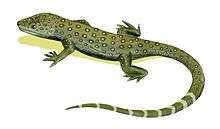Acleistorhinidae
Acleistorhinidae is an extinct family of Late Carboniferous and Early Permian-aged (Moscovian to Kungurian stage) lanthanosuchoid parareptiles. Presently, the clade consists of only three taxa: Colobomycter and Acleistorhinus, both collected from the Permian of Oklahoma, and Carbonodraco from the Carboniferous of Ohio.[2] Sister taxa include Chalcosaurus, Lanthaniscus and Lanthanosuchus.[3]
| Acleistorhinidae | |
|---|---|
 | |
| Skull recontruction of Colobomycter | |
| Scientific classification | |
| Kingdom: | Animalia |
| Phylum: | Chordata |
| Class: | Reptilia |
| Clade: | †Parareptilia |
| Order: | †Procolophonomorpha |
| Superfamily: | †Lanthanosuchoidea |
| Family: | †Acleistorhinidae Daly, 1969[1] |
| Genera | |
Acleistorhinidae is notable for being the oldest-known parareptilian clade. The family is diagnosed by the presence two synapomorphies: (1) the largest tooth is located far anteriorly on the maxilla; and (2) cranial ornamentation consists of sparse and shallow circular dimples.[4]
Diet
Two specimens of acleistorhinids have recently been described from the Richards Spur fissure-fill locality in Oklahoma that provide compelling evidence of the diet of acleistorhinids. These specimens, called OMNH 73362 and OMNH 73364, represent a new and currently unnamed species of acleistorhinid. Fragments of arthropod cuticles are present in between the many palatal teeth of both skulls. The fragments in OMNH 73362 are thought to be the segments of an antenna, while the fragments in OMNH 73364 are thought to be part of a cercus.[5]
In acleistorhinids, the marginal teeth, which are small and recurved, are suggestive of an insectivorous diet, as they probably were used for gripping and piercing arthropod cuticle. The denticulated palate, with three pairs of tooth fields and smaller teeth in between the fields, is seen as an adaptation for holding food in the oral cavity.[5]
The teeth, which possess cutting edges, may also have been suitable for a carnivorous diet in which vertebrate flesh may have been consumed.[6] It is possible that acleistorhinids would have preyed on tetrapods that were small enough to swallow whole.[5] It is likely that one acleistorhinid, Colobomycter pholeter, specialized either on invertebrates with hard cuticles or on small tetrapods.[7]
References
- Daly, E. (1969). "A new procolophonoid reptile from the Early Permian of Oklahoma". Journal of Paleontology. 43 (3): 676–687.
- Arjan Mann; Emily J. McDaniel; Emily R. McColville; Hillary C. Maddin (2019). "Carbonodraco lundi gen et sp. nov., the oldest parareptile, from Linton, Ohio, and new insights into the early radiation of reptiles". Royal Society Open Science. 6 (11): Article ID 191191. doi:10.1098/rsos.191191. PMC 6894558. PMID 31827854.
- Marcello Ruta; Juan C. Cisneros; Torsten Liebrect; Linda A. Tsuji; Johannes Muller (2011). "Amniotes through major biological crises: faunal turnover among Parareptiles and the end-Permian mass extinction". Palaeontology. 54 (5): 1117–1137. doi:10.1111/j.1475-4983.2011.01051.x.
- Modesto, S. P. (1999). "Colobomycter pholeter from the Lower Permian of Oklahoma: a parareptile, not a protorothyrided". Journal of Vertebrate Paleontology. 19 (3): 466–472. doi:10.1080/02724634.1999.10011159.
- Modesto, S. P.; Scott, D. M.; Reisz, R. R. (2009). "Arthropod remains in the oral cavities of fossil reptiles support inference of early insectivory". Biology Letters. 5 (6): 838–840. doi:10.1098/rsbl.2009.0326. PMC 2827974. PMID 19570779.
- Freeman, P. W.; Lemen, C. (2006). "Puncturing ability of idealized canine teeth: edged and non-edged shanks". Journal of Zoology. 269: 51–56. doi:10.1111/j.1469-7998.2006.00049.x.
- Modesto, S. P.; Reisz, R. R. (2008). "New material of Colobomycter pholeter, a small parareptile from the Lower Permian of Oklahoma". Journal of Vertebrate Paleontology. 28 (3): 677–684. doi:10.1671/0272-4634(2008)28[677:NMOCPA]2.0.CO;2.






